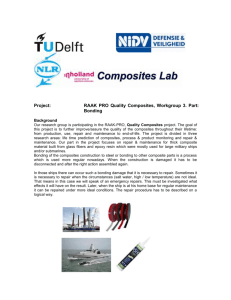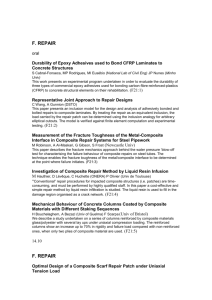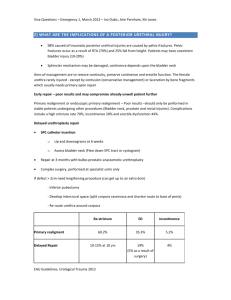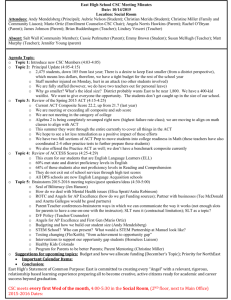(2)
advertisement
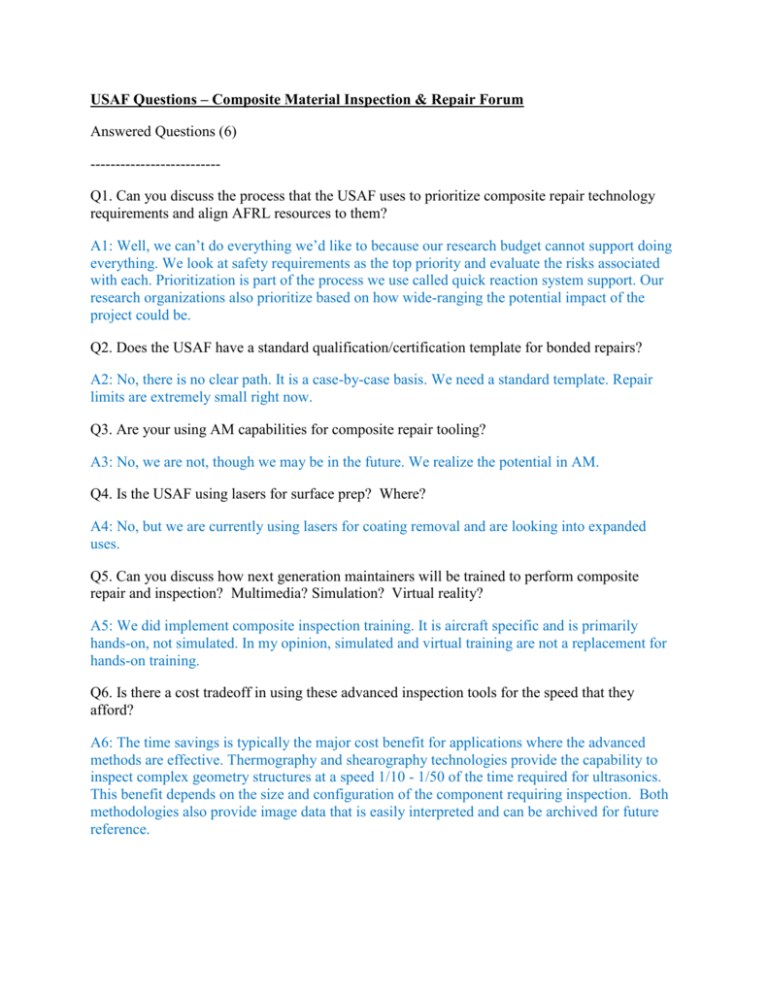
USAF Questions – Composite Material Inspection & Repair Forum Answered Questions (6) -------------------------Q1. Can you discuss the process that the USAF uses to prioritize composite repair technology requirements and align AFRL resources to them? A1: Well, we can’t do everything we’d like to because our research budget cannot support doing everything. We look at safety requirements as the top priority and evaluate the risks associated with each. Prioritization is part of the process we use called quick reaction system support. Our research organizations also prioritize based on how wide-ranging the potential impact of the project could be. Q2. Does the USAF have a standard qualification/certification template for bonded repairs? A2: No, there is no clear path. It is a case-by-case basis. We need a standard template. Repair limits are extremely small right now. Q3. Are your using AM capabilities for composite repair tooling? A3: No, we are not, though we may be in the future. We realize the potential in AM. Q4. Is the USAF using lasers for surface prep? Where? A4: No, but we are currently using lasers for coating removal and are looking into expanded uses. Q5. Can you discuss how next generation maintainers will be trained to perform composite repair and inspection? Multimedia? Simulation? Virtual reality? A5: We did implement composite inspection training. It is aircraft specific and is primarily hands-on, not simulated. In my opinion, simulated and virtual training are not a replacement for hands-on training. Q6. Is there a cost tradeoff in using these advanced inspection tools for the speed that they afford? A6: The time savings is typically the major cost benefit for applications where the advanced methods are effective. Thermography and shearography technologies provide the capability to inspect complex geometry structures at a speed 1/10 - 1/50 of the time required for ultrasonics. This benefit depends on the size and configuration of the component requiring inspection. Both methodologies also provide image data that is easily interpreted and can be archived for future reference. NAVAIR Questions – Composite Material Inspection & Repair Forum Answered Questions (4) -------------------------Q1. Are there issues with cyanate ester resin NDI? A1: We have used thermography. We can see it based on time and can correlate back to thickness. Traditionally, we use ultrasonic. Q2. How hazardous is the cyanate ester resin? A2: Our HAZMAT team saw no issues using it in the lab. It is no more hazardous than traditional methods. Q3. Are there storage/shelf life issues associated with Cyanate ester resin? A3: It can be stored at room temperature, and it is recommended that it be used in the first year. It is as good, or better, than traditional epoxies. Q4. How is the Navy planning to deal with the moisture degradation of uncured Cyanate Ester during storage and repair use? A4: We haven’t seen moisture exposure problems. (We are aware that traditionally Cyanate Ester can have moisture issues). Army Questions – Composite Material Inspection & Repair Forum Answered Questions (4) -------------------------Q1. Is the PIF set up to be a production repair facility? A1: No, the PIF mission is small scale production and repair. Most of the work is for the field, often DMWRs. Q2. When is the next composite maintainers TIM? A2: The meetings occur on an annual basis and the hosts rotate amongst the services. The next one is at Eglin AFB, on June 16-18. Last year it was at Huntsville, AL and over 200 people, including industry, attended. Q3. Does Army aviation use composite repair capabilities resident in Navy and/or USAF depots? A3: No, not really. We don’t have a lot of commonalities. A lot of our structures are different. We do leverage some capabilities, but the Army is only in our infancy, whereas the Navy & Air Force are much further along. Q4. With the increase in complexity of composite parts and use of newer exotic materials, how often are the composite repair engineers included in new part design? The approach seems to be for the most part to design a part/aircraft and figure out how to fix it later. This question is posed to all branches because it has been a problem in the past and cost lots of money to remedy parts that can't be fixed or are extremely limited for repair. A4: The problem is the language in the contracts to the OEM. The OEM either designs for PBL or replacement. Repairs are also often designed after the fact. NAVSEA Questions – Composite Material Inspection & Repair Forum Answered Questions (5) -------------------------Q1. Why such a short commissioned life for the Osprey class boat? A1: It is an Italian design which is in use in the US, and across the world. As soon as production of the Osprey finished, we put it into reserve status to be used as a coastal vessel. Q2. Are ship fires a concern with such extensive use of composite structures on ships? A2: Fires are always a concern with composites. The majority of applications are unmanned systems. For those that are manned, like the hanger, we do add some fire resistant insulation on the interior. Q3. Are we exploring CBM+ built in sensor technology for composite components/structures? A3: We have looked at structural health monitors for probably 20 years. The issue is paying for the monitoring and use of the data. Greg Mellema: This is an excellent topic and the Holy Grail of industry. Every one of these sensors I am aware of has come to a halt. The problem is restoring the connections. Perhaps wireless with self-charging batteries is the solution. Q4. How much automation is used in the inspection and repair process? Robotics? A4: None or very little. Most inspections are very localized. We need to determine the extent of the damage. If it is a large part, it may possibly go back to the OEM. At the field level it’s all manual inspection. Jim Mazza: Very little automation is used in regards to aircraft composite material repair. Q5. Is NAVSEA considering laser surface prep? A5: Not that I am aware of. We looked at multiple methods. Sponge blasting seems to work the best. This Internet message may contain information that is privileged, confidential, and exempt from disclosure. It is intended for use only by the person to whom it is addressed. If you have received this in error, please (1) do not forward or use this information in any way; and (2) contact me immediately.

